Cables are a constant in a guitarist’s life, or so they used to be before guitar wireless systems became common for both the rock star and bar gigger. However, getting rid of the cable is still a tough decision, as the fear of something going wrong when the trusty old jack is not under your feet is still there.
Sharing the same fear, I went through all the most popular systems in the last decade and prepared this list of the best wireless guitar system for all budgets. I have done heavy research and got through my stage failure in the past, so you don’t have to now and can get all the info you need on how to choose and buy wireless systems from my guide.
Bottom Line Up Front
A modern digital wireless guitar system today can be as reliable as a quality cable without being very expensive as long as you choose the right one for the venue you typically play.
Even though the higher, the more reliable they become, any wireless system shares the same failure points as all wireless electronic devices. The longevity of the parts used, the battery, the signal strength, the selectable frequency bands, and the learning curve for using it properly are what you should keep in mind.
How Does a Wireless Guitar System Work?

A wireless guitar system works similarly to any closed wireless system. A receiver is plugged into the amp (or anywhere you end your chain), and a transmitter is plugged into the guitar – both of which communicate in various selectable frequency ranges depending on the model used.
What Frequencies Do Wireless Guitar Systems Use?
- Guitar wireless systems use very High Frequency (VHF) in the range of 30 to 300 megahertz (MHz) Ultra High Frequency (UHF) in the range of 300 MHz to 3 gigahertz radio waves.
- Modern-day digital systems use the industry standard 2.4 GHz band, approved for wireless instruments and overall wireless technology.
- Professional touring artists generally use specific safe channels for which they buy a yearly license. At the date of writing, the most used is channel 39.
Wireless Guitar System vs Cable
Nowadays, using a wireless guitar system is not any riskier than using a standard cable if you know how to set up the transmit and receiver and respect its distance and charge limits.
While it’s commonly said that fewer cables equal less trouble, my rule of thumb is that any quality cable will do much better than a poor wireless system, while a good wireless system, if setup up right, will be safer and give you much more freedom than a cable can.
Why Use a Wireless Guitar System?

- More freedom to perform on stage for the entire band
- Fewer cables to step on for everyone on the band
- No signal loss or effect on the guitar tone
- Essentially no risk of fault when using quality systems
Why Avoid Wireless Guitar Systems?
- You need to remember to charge or replace the battery of the units
- There’s a limit to the distance you can move from the receiver
- Other instruments’ signals can occasionally interfere with yours
- Some High-end systems for pro artists require yearly licenses for channels.
- Cheap systems often cause latency issues.
- Advanced systems to play on big stages are very expensive.
Analog vs Digital Wireless Guitar System
When they first came out, there were all kinds of stories of analog transmitters during shows picking up police radio waves in the area among passing FM frequencies from local radio stations.
Analog transmitters have low latency, strong signal, many channels, and high bandwidth; analog wireless systems suffer from interference from other channels, can compress and ‘color’ the sound, and are harder to pair.
Digital transmitters are overall more reliable, cheaper, easier to use, and add no coloring to the sound. The downsides go hand in hand with the price; many affordable alternatives suffer from latency issues the bigger the show and setup gets.
What to Look for in a Wireless Guitar System?
Depending on the size of the venues your band plays, you need a good balance of price/reliability for your rig. A more expensive system won’t improve your tone but will be far more reliable than a cheap one.
- The maximum transmission range (signal strength) should fit the typical venues you play and preferably exceed what you usually need to as a precaution for tricky venues with thick walls or barriers.
- The frequency ranges and flexibility to change frequency ranges automatically or manually is crucial to avoid lack and latency. While 2.4 GHz is safe, you need to be able to switch between ranges to suit different wireless instruments on stage.
- No latency whatsoever at close range. Even if the audience can’t hear it, you can feel the slightest latency in your hands.
- The frequency response should cover the most out of 20-2000 kHz, the limit in which instruments and human ears operate.
- The system should make it for two gigs with a full charge in case you forget to charge it and have a clear indicator for when the battery is low.
- No noise or hiss at loud volumes for expensive units and just enough to kill with a low-rate gate in affordable ones.
- Solidly built and reliable enough to handle months of daily playing
If you are part of a well-known artist’s touring band, all of the above are sorted by pro-grade systems that are built considering all situations and use specific safe channels.
How to Properly Use a Wireless Guitar System?
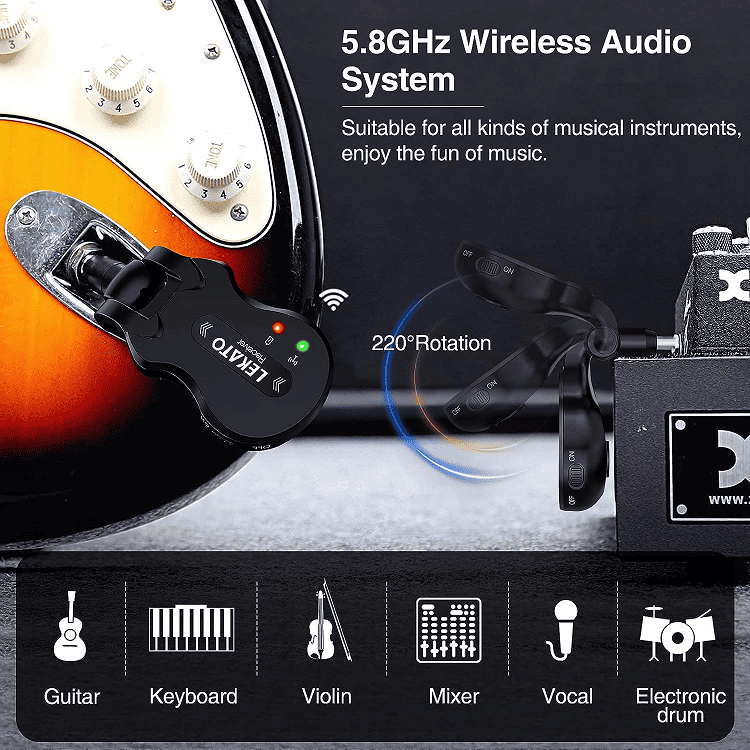
All wireless systems have a learning curve and specific routine to follow to make the most use of them and avoid any trouble on stage.
- Always check the battery level and keep spare batteries and a charger. Keep receivers plugged in if they come with a power supply.
- If the receiver has an antenna, put it as far from metal surfaces as possible to avoid interference; if there are two antennas, position them in a V shape.
- Make sure to pair the receiver and transmitter using automatic or manual scanning and that they’re not turned off or muted.
- Select the right channel (manually or automatically) and test the connection during soundcheck when all other instruments are connected.
- If you use multiple wireless systems simultaneously, assign them to different channels of the same group to avoid interference, referred to as intermodulation.
- Stay within the maximum distance from the receiver to avoid signal lack and keep it in sight, avoiding objects, walls, or many people in the way.
- Be careful not to accidentally hit the receiver and knock it off the guitar (especially on Strat or Tele), as it’s bigger than the cable’s head.
After everything is working, adjust the volume and gain as follows:
- Set the volume output on the system to max for a more dynamic range and the gain levels up to where you don’t get any distortion.
- Set the RF (Radio Frequency Strength) to max for the best quality and too low to save the battery.
- Squelch is a setting that silences wanted background noise. Always set it to pass the audio signal and only mute the background noise.
Where Should I Place the Receiver?
Depending on your setup, the receiver can go on the amp, mixing desk, audio interface, or pedal board. The best option for a regular gigger is placing a receiver at the beginning of the board.
Do Wireless Systems Work with Active Pickups/Electronics?
Not all wireless systems work with high-output electric guitar active pickups or a plugged-in acoustic-electric. Check the specs of what you buy or buy a specific unit for the job.
Best Affordable Guitar Wireless Systems
You have to be careful when picking wireless guitar systems under 100$. While all promise to work just as well as a professional system, only some are reliable enough for a small to average-sized venue and will last for months or years.
These systems are suited for beginners, regular weekend giggers, and/or players who seldom use a wireless system. If you choose a proper one and follow the abovementioned steps, you will have a fully working, no latency system.
The downside of all affordable wireless systems is they are not great at handling the unexpected and likely fail when outside conditions you have no control over put too much pressure on them.
If the venue is shaped oddly with too many walls or the receiver has to go directly to the mixing board on the far side of the room, you might experience lag on the guitar.
The main thing to look for in an affordable system is the lack of latency at close to average distance and the ability to pick between a few channels. Don’t look for antennas, big separate unit receivers, and solid metal materials in this range.
LEKATO 5.8Ghz Wireless Guitar System 4 Channels – Most Reliable Affordable System

The LEKATO 5.8 GHz, compared to expensive systems, is like the Squire to the Strat. The Strat is much more costly, yet a quality Squire can do a great job if the setting is right.
I have used this system for playing bass and guitar on weekend venues for years and never had a problem as long as I tested it during soundcheck. It’s very straightforward and what most players need on a budget.
Considering the price, the only thing I would improve is make the transmitter and receiver slightly more apparent as it’s easy to confuse them. The high gain hiss is rare but easily amendable with a slight gate.
The LEKATO has its limitation, and I eventually upgraded to a pro-grade set only when the venues started getting bigger as I stepped into the session world.
Behringer Airplay Guitar AG10 Digital Wireless Guitar System – Best Battery Life
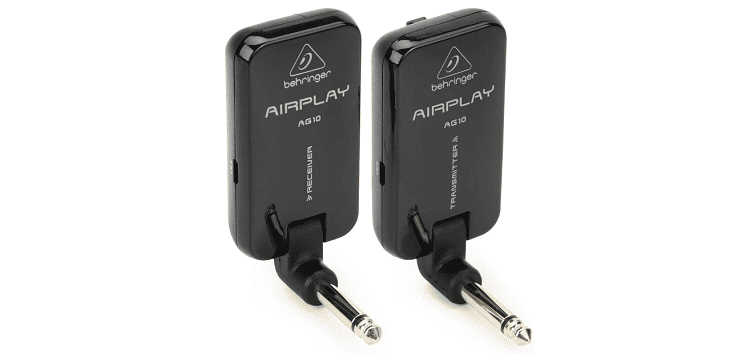
The AG10 is very similar to the LEKATO system in how they operate. It does not have as strong a signal and can get noisy at loud volumes if you don’t use the gate at the start of your rig. On the upside, the battery is highly reliable and charges fast.
SWIFF High-Grade Electronic Guitar Wireless System – The Most Channels
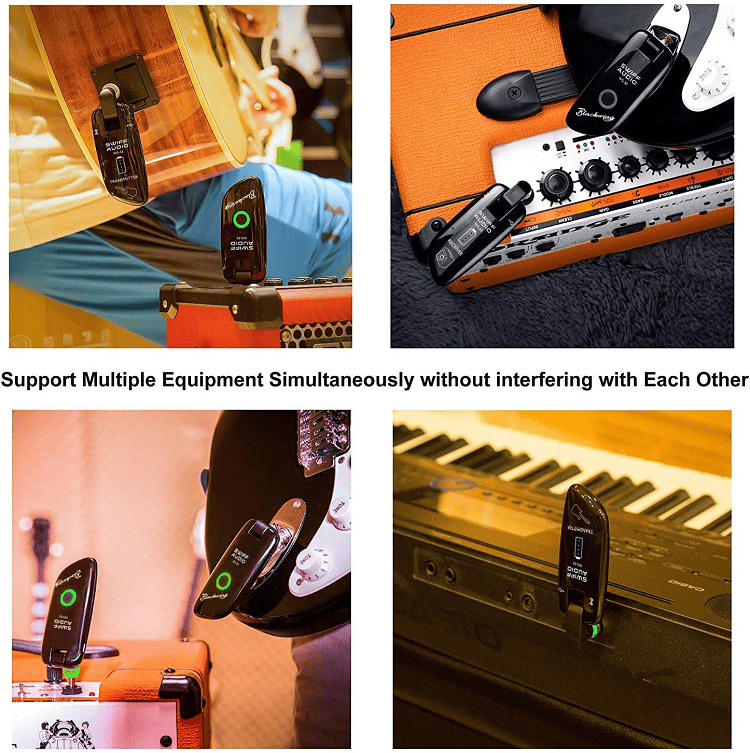
The SWIFF‘s most significant advantage is the number of instruments you can use simultaneously. The signal strength and frequency response are not the best on the list though.
Best Intermediate Guitar Wireless Systems
Wireless systems cost as much as a quality pedal or
These systems suit regular small-average venue players who occasionally play on a bigger stage. The options here are safer, as most if not all, will cause no problems. You don’t have to worry about everyday issues like battery failure, the equipment breaking down, or lagging at close to average distance.
The disadvantage of intermediate guitar wireless systems is that they can’t always handle the unexpected in bigger venues and stages where failure or latency is not accepted.
While I have played festivals with a few of these units, trust them only if the soundcheck went 100% smoothly – In a high-pressure situation, go for the cable at the first sign of lag or noise.
Ibanez WS1 Guitar Wireless System – Small and Easy to Use

The WS1 follows the logic of two small pocked-sized units you can carry everywhere. It has a great range and a cable tone simulator, yet it is less powerful and is battery-powered – differently than systems with a separate big transmitter.
Boss WL-50 Guitar Wireless System – Intelligent Design
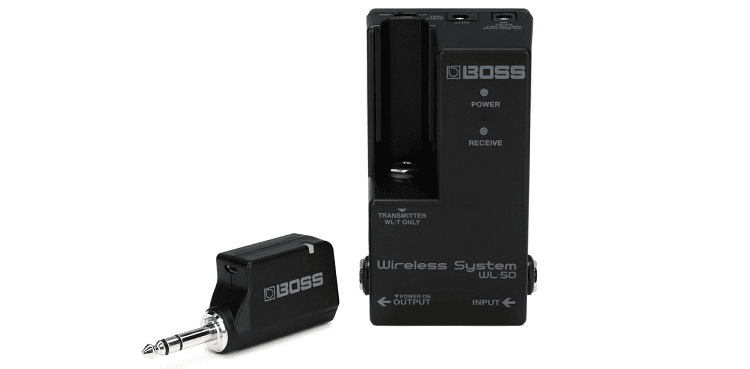
The WL-50‘s most significant advantage is the transmitter design which fits on a pedal board like a pedal. You place the transmitter on your feet, connect it to the power source, and don’t worry much about distance or battery.
Line 6 Relay G30 Digital Wireless Guitar System – Strongest Signal
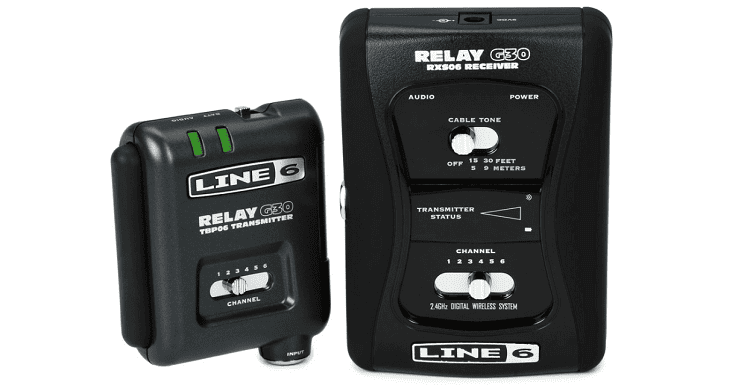
The G-30 is overall the most powerful system among the three with its range and arguably the most reliable. You can place the receiver handily on the pedal board, yet you still need to run a short cable from the guitar to the bodypack transmitter.
Best Professional Guitar Wireless Systems
In the premium range of wireless systems, prices equal that of an excellent used high-end guitar or special intermediate one. Once you get to the level of playing big stages, often with your band or as a session musician, you can’t allow yourself to have flaws in your rig.
As reliable, professional gear, pro-grade systems have no direct disadvantage or risk of lagging like intermediate units. What would make you pick one unit instead of the other relates more to your band’s setup and whether you need more range, more simultaneous channels, or work on a specific band.
If you’re lucky enough to have a crew, ask your guitar tech or engineer before picking on. They are the ones who will most likely use it on your behalf.
Shure GLXD14+ Digital Wireless Bodypack System – Best Value

The GLXD14+ price is often the starting point for professional systems. It will work perfectly in any situation, exactly a more expensive unit double its price. The only area where it lags compared to those systems is that it’s not a rackmount but a tabletop unit with a slightly shorter range.
Sennheiser EW 500 G4-Ci1 Wireless Guitar System – Most Channel
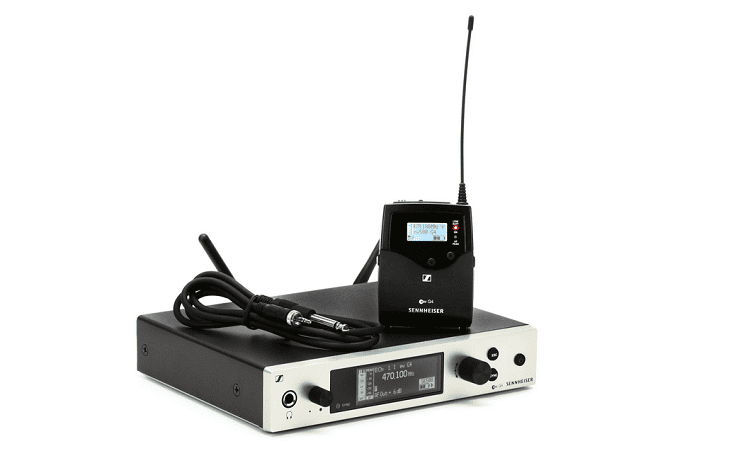
The EW 500 is a pro-grade unit with 32 simultaneous channels and extraordinary signal strength. The downside is the non-rechargeable transmitter batteries.
Shure QLXD14 Wireless Guitar System – H50 Band – The Overall Best
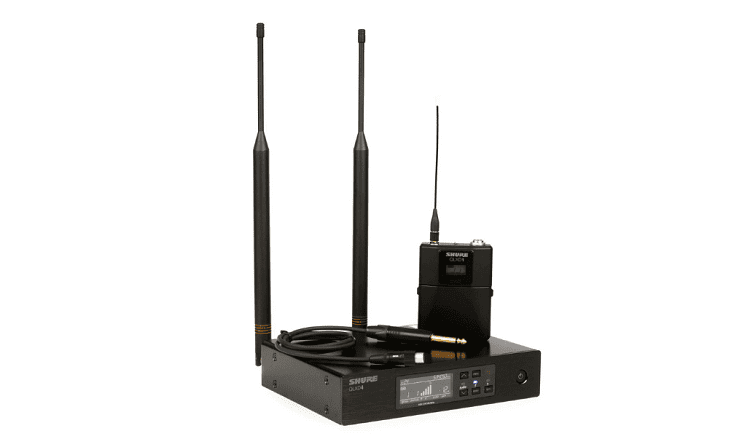
The QLXD14 is a high-end costly system with which you can pull a world tour as many famous players do. The receiver fits perfectly in your rack, only takes up 0.5 space, and connects with a tap, making any guitar tech happy.
If you’re settled in the US, The Sure Frequency Finder will help you find the best frequency bands to use and pick between the QLXD14 H50, V50, G50, and J50A.
FAQs
Question: Does a Wireless Guitar System Affect the Tone?
Answer: Despite the many opinions and famous players like Steve Vai, who still use a cable to get a ‘raw’ tone, a modern wireless guitar system does not affect the tone at all – In fact, the signal from good wireless equipment has less loss than a long cable, doesn’t need any buffers along the way.
Considering how passionate some musicians are about the cable ‘tone,’ some expensive wireless system has a switch that emulates the ‘vintage’ signal loss of a cable.
Question: How Likely is a Guitar Wireless System to Fail?
Answer: A well-tested and set up wireless guitar system will rarely fail on a stage If you respect the distance from the receiver, check the battery limit, and pick and test the right frequency ranges.
Question: Do I Need Specific Wireless Systems for Bass, Baritone, and 7-8 String Guitars?
Answer: A wireless system for guitar will work on a bass as long as it has high-quality digital transmission; analog transmitters suffer from signal loss in the low range.
Best Wireless Guitar Systems: Only Buy in Your Range
It’s good to have quality gear, but if you mostly play small-middle-sized venues, there are better investments than a premium long-range wireless system. Delicate equipment on which a show depends should be reliable, but there are other fault points to take care of first that the sound guys need help with.
A good tone will give your more freedom than any wireless system. For the same price as a high-end system, you could buy a value one and spend the rest on pedals that shape your tone, pickups that kills feedback, a new cabinet, or anything that will make sound better.
You don’t always need the best system if you’re not playing concerts regularly. However, if you compromise, it’s best to compromise on the range rather than the ability to choose frequencies.
- Do you Actually Need a Trembucker? Humbucker vs Trembucker - May 11, 2024
- Best Headphones for Guitar Amp Guide - April 23, 2024
- Takamine vs Martin Comparison – US-Made Legacy Against Japanese Precision - March 30, 2024

